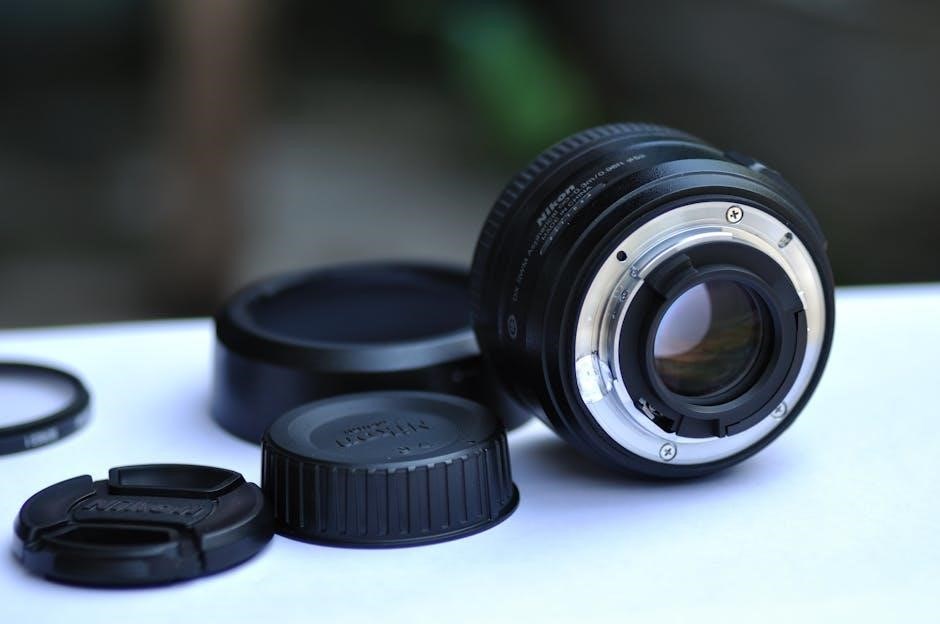Safety Precautions
Always follow safety guidelines to avoid serious injury or fatalities. Avoid testing voltages in damp or wet conditions. Inspect the multimeter and leads for damage before use. Use the multimeter only as specified in the manual. Never test voltages higher than 1000V DC or 750V AC. Ensure proper ventilation and avoid overloading circuits. Work with a partner when possible to ensure assistance is available in case of an emergency. Failure to comply with these precautions can result in severe consequences.
1.1. General Safety Guidelines
Always inspect the multimeter and test leads for damage before use. Ensure the multimeter is properly calibrated and functioning within specified ranges. Avoid using the device in damp or wet conditions to prevent electrical hazards. Never exceed the maximum voltage or current ratings specified in the manual. Use the correct function and range for the measurement to avoid damage or inaccurate readings. Follow all safety precautions to ensure safe and reliable operation.
1.2. Hazardous Situations and Consequences
Testing voltages in damp or wet environments can lead to electric shock, resulting in severe injury or death. Exceeding the multimeter’s maximum voltage or current ratings can cause irreversible damage or even fire. Using damaged test leads or ignoring safety guidelines increases the risk of faulty connections and potential accidents. Failure to adhere to these precautions can have severe consequences, including injury or death.
1.3. Importance of Following Safety Guidelines
Adhering to safety guidelines is crucial to prevent accidents and ensure reliable measurements. Proper usage prevents damage to the multimeter and protects users from electric shock or fire hazards. Ignoring safety protocols can lead to serious injury or death, especially when testing high voltages or in damp conditions. Always follow the manual’s instructions to maintain safety and ensure accurate results. Compliance with safety standards is essential for both personal protection and optimal tool performance.

Understanding the Cen-Tech Digital Multimeter
The Cen-Tech Digital Multimeter is a versatile tool designed for measuring voltage, current, resistance, and more. It offers precise readings for various electrical tasks, ensuring accuracy and reliability.
2.1. Key Features and Functions
The Cen-Tech Digital Multimeter offers a range of functions including voltage (AC/DC), current (AC/DC), resistance, and diode testing. It also features transistor measurements and battery testing capabilities. The multimeter includes a backlit display for visibility and audible continuity testing for convenience. With multiple ranges and automatic functions, it provides accurate readings for various electrical projects. Its compact design and user-friendly interface make it ideal for both professionals and DIY enthusiasts.
2.2. Identifying the Model Number
Locate the model number on the multimeter’s casing or product packaging. Common models include 98025, 69096, and 95652. Identifying the correct model ensures access to the appropriate manual and support. Referencing the wrong model may lead to incorrect usage or safety risks. Always verify the model number before operating or troubleshooting to ensure compatibility with instructions and accessories. This step is crucial for safe and effective use of the device.
2.3. Included Components (Multimeter and Test Leads)
Your Cen-Tech digital multimeter package includes the main unit and a set of red and black test leads. Ensure all components are present and undamaged upon unpacking. If any parts are missing or broken, contact Harbor Freight Tools immediately. Properly inspecting and verifying the included components ensures optimal performance and safety. Familiarize yourself with each part before use to avoid operational issues. This step is essential for a smooth and effective user experience.
Setting Up the Multimeter
Start by carefully unpacking the multimeter and verifying all components. Install the battery as directed and familiarize yourself with the device’s interface.
3.1. Unpacking and Inventory Check
Begin by carefully unpacking the multimeter to ensure all components are included. Check for the digital multimeter unit, red and black test leads, and the user manual. Verify that no parts are missing or damaged. If any components are absent or broken, contact Harbor Freight Tools immediately. Properly inspecting the contents ensures readiness for safe and effective use of the device.
3.2. Battery Installation and Management
Install a 9V battery to power the multimeter. Open the battery compartment, insert the battery correctly, and close it securely. Avoid opening the compartment while the multimeter is powered. Replace the battery when the display fades or measurements become inconsistent. Always use the recommended battery type to ensure optimal performance. Refer to the manual for specific instructions to maintain proper functionality and safety.
3.3. Familiarizing Yourself with the Interface
Examine the multimeter’s interface, starting with the digital display showing measurements. Identify the function buttons for selecting modes like voltage, current, and resistance. Locate the rotary dial for choosing measurement ranges. Note the input jacks for connecting test leads. Understand the power button and battery compartment. Familiarize yourself with the transistor and diode test positions. Ensure you recognize all controls before operating to ensure accurate and safe measurements.

Operating the Multimeter
Select the desired function using the rotary dial or function buttons. Ensure test leads are securely connected to the correct input jacks. For unknown measurements, start with the highest range. Press the power button to activate the multimeter. Use the digital display to read accurate results. Avoid overloading circuits to prevent damage to the device or injury.
4.1. Mastering Resistance Measurement
To measure resistance, select the resistance function (often marked with an ohm symbol, Ω) on the multimeter. Connect the black lead to the COM jack and the red lead to the VΩ jack. Ensure the component is powered off. For accurate readings, choose the appropriate range by turning the range selector. Start with the highest range if the resistance value is unknown. Hold the leads firmly on the component terminals to avoid fluctuating readings. The multimeter will display the resistance value, allowing you to diagnose issues like open circuits or short circuits effectively.
4.2. Voltage Measurement (AC and DC)
For voltage measurement, select the DC or AC voltage function on the multimeter. Connect the black lead to the COM jack and the red lead to the V jack. Ensure the device is powered on. Choose the appropriate range by turning the range selector, starting with the highest range if the voltage is unknown. Press the range button to cycle through options. For DC voltage, ensure the multimeter is set to DC mode to avoid incorrect readings. Measure directly across the component or circuit terminals, ensuring the multimeter is set to the correct voltage type (AC or DC) before connecting the leads to avoid damage.
4;3. Current Measurement (AC and DC)
For current measurement, select DC or AC current mode on the multimeter. Connect the black lead to the COM jack and the red lead to the 10A or 200mA jack, depending on the expected current level. Always start with the highest range if the current is unknown. Press the range button to cycle through options. Ensure the multimeter is set to DC or AC mode before connecting the leads. Measure directly across the circuit, avoiding high current levels that exceed the multimeter’s capacity to prevent damage.
4.4. Diode Testing and Transistor Measurements
To test diodes, set the multimeter to the diode function (⌲ symbol). Connect the red lead to the diode’s anode and the black lead to the cathode. A healthy diode will show a low voltage drop (typically 0.4-0.7V) in forward bias and high resistance in reverse. For transistors, use the hFE (transistor symbol) function. Place the transistor in the test socket or connect leads to its terminals to measure current gain. Ensure the multimeter is set to the correct mode for accurate results. Always avoid reverse polarity to prevent damage.

Advanced Functions
The Cen-Tech multimeter includes advanced features like audible continuity testing, battery testing, and frequency measurement. These functions enhance diagnostic capabilities for complex electrical and electronic circuits. Use them wisely.
5.1. Audible Continuity Testing
Audible continuity testing is a convenient feature that emits a beeping sound when a complete circuit is detected. This function is useful for quickly identifying short circuits or verifying connections without constantly monitoring the display. To use it, select the continuity mode on the multimeter, ensure the circuit is de-energized, and touch the probes to the test points. The audible signal confirms continuity, saving time during troubleshooting. Always ensure the circuit is safe to test before proceeding.
5.2. Battery Testing
Battery testing on your Cen-Tech digital multimeter allows you to assess the condition of batteries by measuring their voltage. Set the multimeter to DC voltage mode and touch the black and red probes to the battery terminals. The displayed voltage indicates the battery’s charge level. For example, a 12V battery should read around 12.6V when fully charged. Lower readings may indicate a weak or discharged battery. Always ensure the battery is disconnected from the circuit during testing for accurate results.
5.3. Frequency Measurement
The Cen-Tech digital multimeter allows you to measure the frequency of an AC signal, which is essential for diagnosing electrical circuits. Set the multimeter to frequency mode, connect the test leads to the circuit, and the display will show the frequency in Hz. This function operates within a range of 45 to 450 Hz, ensuring accurate measurements for various applications. Always refer to the manual for specific instructions tailored to your multimeter model to ensure precise and safe operation.

Using the Multimeter for Specific Tasks
Learn to apply your Cen-Tech multimeter for testing batteries, measuring AC/DC voltage, and troubleshooting electrical issues. These tasks simplify diagnosing and repairing common electrical problems effectively.
6.1. Testing a 12V Lawn Tractor Battery
To test a 12V lawn tractor battery, set the multimeter to DC voltage mode (DCV) and select the 20V range. Connect the red lead to the positive terminal and the black lead to the negative terminal. Ensure the battery is disconnected from the tractor. A fully charged battery should read between 12.4V and 12.7V. If the reading is below 12V, the battery may need charging or replacement. Use the hold function to stabilize the reading for accuracy.
6.2. Measuring Voltage in AC and DC Circuits
To measure voltage in AC or DC circuits, set the multimeter to the appropriate mode (ACV or DCV). Select the highest range if the voltage is unknown. Connect the red lead to the positive terminal and the black lead to the negative terminal. For AC circuits, ensure the frequency matches the multimeter’s range (45-450 Hz). Avoid exceeding the multimeter’s voltage limits (1000V DC, 750V AC). Always disconnect power before measurement and ensure proper lead connections to avoid errors or damage to the device.
6.3. Troubleshooting Electrical Issues
Identify the problem area by visually inspecting wires and connections. Use the multimeter to check for short circuits, open circuits, or faulty components. Test continuity to locate breaks in the circuit. Measure resistance to detect shorted or open components. Verify voltage levels at key points to ensure proper power distribution. Use the multimeter’s functions to isolate faults systematically. Always disconnect power before testing and ensure leads are securely connected for accurate readings. Refer to the manual for specific settings and procedures to avoid errors or damage.
Maintenance and Care
Regularly clean the multimeter with a soft, dry cloth. Store it in a dry, protective case to prevent damage. Replace the battery as specified in the manual. Check test leads for wear and ensure all components are secure. Proper storage and maintenance ensure accurate measurements and extend the multimeter’s lifespan.
7.1. Cleaning the Multimeter
Clean the multimeter with a soft, dry cloth to remove dirt and debris; Avoid using harsh chemicals or abrasive materials that could damage the surface. For the test leads, use a soft brush or dry cloth to ensure clean connections. Never expose the multimeter to moisture during cleaning. Regular cleaning ensures accurate measurements and prevents wear. Store the multimeter in a protective case when not in use to maintain its condition and functionality over time.
7.2. Storing the Multimeter Properly
Store the multimeter in a cool, dry place to prevent damage. Use a protective case to shield it from dust and physical harm. Avoid exposing it to extreme temperatures or humidity. Keep it away from direct sunlight and moisture. Do not store it in damp or wet environments. Ensure the multimeter is turned off before storage to conserve battery life. Proper storage maintains its accuracy and extends its lifespan, ensuring reliable performance for future use.
7.3. Replacing the Battery
Turn off the multimeter before replacing the battery; Open the battery compartment, usually located on the rear or side. Remove the old 9V battery and insert a new one, ensuring correct polarity. Close the compartment securely. Properly dispose of the old battery. Check for a low battery indicator after replacement to confirm functionality. Always use the recommended battery type to maintain performance and avoid damage to the multimeter.

Common Models and Their Manuals
Popular models include the Cen-Tech 98025, 69096, and 95652. Each model’s manual provides detailed setup, operation, and safety guidelines specific to its features and functions.
8.1. Cen-Tech 98025 Multimeter
The Cen-Tech 98025 is a seven-function digital multimeter designed for measuring voltage, current, resistance, and more. Its manual includes setup, operation, and safety guidelines. Rated 9.5/10, it covers DC/AC voltage, resistance, transistor testing, and battery testing. The 8-page manual emphasizes safety precautions, such as avoiding voltages above 1000V DC or 750V AC. Proper usage and maintenance instructions are provided to ensure accurate measurements and extend the device’s lifespan. Always refer to the manual for specific operational details and safety protocols.
8.2. Cen-Tech 69096 Multimeter
The Cen-Tech 69096 is a 7-function digital multimeter offering precise measurements for voltage, current, and resistance. Its manual provides detailed instructions for setup and operation, emphasizing safety. Rated highly for reliability, it includes features like diode testing and transistor measurements. The manual highlights precautions to avoid damage and ensures accurate readings. Users are advised to follow guidelines strictly to maintain functionality and safety. This model is ideal for both professionals and DIY enthusiasts, covering a wide range of electrical tasks efficiently.
8.3. Cen-Tech 95652 Multimeter
The Cen-Tech 95652 multimeter is a versatile tool for measuring voltage, current, resistance, and more. Its manual provides clear instructions for setup and operation, ensuring safe use. Features include a backlit display for visibility and advanced functions like diode testing. The manual emphasizes proper handling and troubleshooting, making it essential for both professionals and DIYers. This model is known for its reliability and ease of use, catering to various electrical tasks with precision and accuracy.

Warranty and Support
The Cen-Tech digital multimeter is backed by a limited 90-day warranty. For technical support or replacement parts, contact Harbor Freight Tools at 1-800-444-3353 for assistance.
9.1. Limited 90-Day Warranty Details
The Cen-Tech digital multimeter comes with a limited 90-day warranty covering defects in materials and workmanship. This warranty begins on the purchase date and applies to the original buyer. For warranty claims, contact Harbor Freight Tools at 1-800-444-3353. Damages from misuse, improper maintenance, or normal wear are excluded. Keep your purchase receipt and this manual for warranty processing. Warranty details are outlined in the manual provided with your multimeter.
9.2. Contacting Harbor Freight Tools for Assistance
For technical questions or replacement parts, contact Harbor Freight Tools at 1-800-444-3353. Their customer service team is available to assist with inquiries related to your Cen-Tech digital multimeter. Visit their website at http://www.harborfreight.com for additional resources. Ensure you have your product details and purchase information ready when reaching out. This service is exclusively for issues related to Harbor Freight Tools products, including the Cen-Tech multimeter series.

Tips for Getting the Most Out of Your Multimeter
Start with the highest range for unknown measurements. Use the correct test leads and avoid damp conditions. Calibrate before use and reference the manual for specific functions.
10.1. Starting with the Highest Range for Unknown Measurements
Always begin with the highest range setting when measuring unknown values to prevent damage to the multimeter. This ensures the device can handle unexpected high voltages or currents. For DC current measurements, start with the 10A range and adjust to lower ranges as needed. This approach protects the meter and provides accurate readings. Refer to the manual for specific range recommendations and follow safety guidelines to avoid potential hazards during measurement.
10.2. Avoiding Damages to the Meter
To prevent damage to your Cen-Tech digital multimeter, avoid overloading the input with voltages or currents beyond its rated specifications. Always use the correct range for the measurement to prevent overload. Inspect test leads for damage before use and ensure proper connections to avoid short circuits. Never touch the meter’s terminals with bare hands, as static electricity can cause internal damage. Avoid operating the multimeter in damp or wet conditions, as moisture can compromise its internal components. Regular cleaning and proper storage also help maintain the meter’s functionality and longevity.
10.3. Using the Multimeter in Damp or Wet Conditions
Using the multimeter in damp or wet conditions can lead to electrical hazards and internal damage. Always ensure the multimeter and test leads are dry before and during use. Moisture can compromise insulation and create unsafe conditions. If exposure to moisture occurs, thoroughly dry the device before use. Consider using a water-resistant case for added protection. Avoid measuring high voltages in humid environments to prevent accidental short circuits or electrical shock.
Troubleshooting Common Issues
Identify missing or broken parts and contact support. Check for loose connections and correct range settings for accurate measurements. Address battery drain by replacing or charging the battery promptly.
11.1. Missing or Broken Parts
If any components like test leads or the multimeter casing are missing or damaged, immediately contact Harbor Freight Tools at 1-800-444-3353. Inspect all parts before use to ensure functionality. Missing parts can render the multimeter inoperable, while broken components may lead to inaccurate readings or safety hazards. Always verify the completeness and condition of your multimeter upon unpacking and after storage.
11.2. Incorrect Measurements
Incorrect measurements may occur due to improper range selection or damaged test leads. Always start with the highest range for unknown values to ensure accuracy. Verify that the multimeter and leads are in good condition before use. Consult the manual for correct function settings. If issues persist, calibration or professional servicing may be required. Ensure proper lead placement and avoid cross-connections to maintain measurement integrity and safety.
11.3. Battery Drain or Low Power
Battery drain or low power can cause inaccurate measurements. Check the battery life before use and replace it if necessary. Avoid leaving the multimeter in high-drain modes. Store the device properly to prevent battery depletion. If low power persists, consult the manual for troubleshooting steps. Ensure the multimeter is turned off when not in use to preserve battery life. Always use the recommended battery type to maintain optimal performance and accuracy.
Always referencia the manual for safe and effective use. Proper care and maintenance ensure accurate measurements. Troubleshoot issues promptly to maintain functionality. Follow safety guidelines strictly.
12.1. Final Tips for Safe and Effective Use
Always start with the highest range for unknown measurements to avoid damage. Regularly inspect leads and probes for damage. Store the multimeter in a dry, cool place to maintain accuracy. Refer to the manual for specific functions and troubleshooting. Avoid using the multimeter in hazardous environments or near flammable materials. Keep the device away from children and unauthorized users. Proper care ensures longevity and reliable performance.
12.2. Importance of Referencing the Manual
Referencing the manual is crucial for safe and effective use of your Cen-Tech digital multimeter. It provides detailed instructions for setup, operation, and troubleshooting specific to your model. The manual outlines safety precautions, warranty details, and contact information for support. Understanding the features and functions through the manual ensures optimal performance and longevity of the device. Always keep it handy for quick reference to avoid errors and maintain compliance with manufacturer guidelines.
12.3. Resources for Further Assistance
For additional support, visit Harbor Freight Tools’ website or contact their customer service at 1-800-444-3353. Online forums and user communities offer troubleshooting tips and shared experiences. Official Cen-Tech multimeter manuals are available on platforms like ManualsLib, providing detailed guides and specifications. Utilize these resources to resolve issues, explore advanced features, and ensure proper usage of your multimeter for optimal performance and safety.
